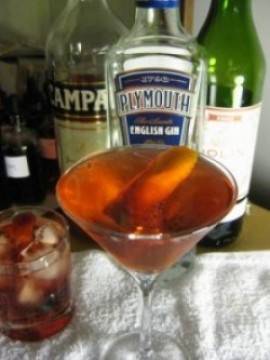In recent years, an incredibly successful marketing plan on the part of Gruppo Campari, the large liquor conglomerate based in Milan, has led to the appearance of a bottle of Campari in what seems like every bar in America, despite Americans general dislike of the liqueur. Campari has a distinctly un-American taste. It is at once intensely bitter and sweet, with a taste primarily of grapefruit and a color that is natural only on creatures native to tropical reefs. It is also the distinctive ingredient in one of the most de rigeur cocktails of the last ten years: The Negroni.
 It’s worth taking a quick detour to talk about Campari, here, since it’s part of a unique group of liqueurs. Campari is actually kind of a gateway liqueur; it’s on the fringe of a whole slew of Italian bitter aperitifs and digestifs, which are generally called amaro (plural amari). Most amari are herbal — think Jagermeister but without the frat-boy image — but there’s huge regional variation in alcoholic proof, exact flavoring, and style, with at least 300 different amari produced throughout Italy. Some, like the fairly well-known Fernet Branca are dry and bitter, almost medicinal. Others, like the gentle Amaro Montenegro, are more spiced than bittered, with warm flavors that welcome newcomers. There are even amari flavored with truffles, although I’ve not been lucky enough to try them. Campari is a grapefruit-based amaro. It has two cousins from the same manufacturer: Cynar, an artichoke-based amaro (it’s less weird than it sounds, promise), and Aperol, an orange-rhubarb amaro, which is by far the most approachable of the bunch. All three are widely available in the C-U area, as are a number of other amari (including the Amaro Montenegro, which I recommend to those wishing to start off easy).
It’s worth taking a quick detour to talk about Campari, here, since it’s part of a unique group of liqueurs. Campari is actually kind of a gateway liqueur; it’s on the fringe of a whole slew of Italian bitter aperitifs and digestifs, which are generally called amaro (plural amari). Most amari are herbal — think Jagermeister but without the frat-boy image — but there’s huge regional variation in alcoholic proof, exact flavoring, and style, with at least 300 different amari produced throughout Italy. Some, like the fairly well-known Fernet Branca are dry and bitter, almost medicinal. Others, like the gentle Amaro Montenegro, are more spiced than bittered, with warm flavors that welcome newcomers. There are even amari flavored with truffles, although I’ve not been lucky enough to try them. Campari is a grapefruit-based amaro. It has two cousins from the same manufacturer: Cynar, an artichoke-based amaro (it’s less weird than it sounds, promise), and Aperol, an orange-rhubarb amaro, which is by far the most approachable of the bunch. All three are widely available in the C-U area, as are a number of other amari (including the Amaro Montenegro, which I recommend to those wishing to start off easy).
The Negroni is theoretically a fairly venerable cocktail. It is said to have originated in the early twentieth century as a variation on another Campari-based cocktail, The Americano, which is a combination of Campari, sweet vermouth, and soda water (and is my preferred summer cooler). The Negroni, supposedly at the instigation of an eponymous Count Negroni, swapped out soda water for gin, remaking a low-proof sparkler into something more akin to the whole iron-fist-in-velvet thing. The history is actually fairly questionable, and unless someone has a copy I can borrow of Sulle tracce del conte: La vera storia del cocktail Negroni, which translates to “On the Trail of the Count: The True Story of the the Negroni Cocktail”, it’s likely to remain that way for the moment.

The Negroni
- 1 1/2 oz gin
- 3/4 oz sweet vermouth
- 3/4 oz Campari
Combine ingredients, stir well with ice. Strain into a cocktail glass, and garnish with an orange peel
Classically, the Negroni is made with equal proportions — that is, 1 part each of the three ingredients. While this is wonderful for giving instructions to a bartender, it makes a drink that is, to my mind, hugely sweet and syrupy. I prefer a version made with double the gin, which produces a cocktail that is still sweet, but much more palatable for the modern drinker.
The Negroni is a drink that lends itself to substitutions. Swap out the gin for bourbon and you have a Boulevardier, although you’ll need to add a dash of orange bitters. Changing to tequila from the Boulevardier makes the unfortunately named (but delicious) Agavoni. Make the vermouth dry and switch the gin for rye, and you’ve got an Old Pal. Throw out everything and toss in gin’s Scandinavian cousin aquavit, vermouth’s un-aromatized relative sherry, and Cynar, Campari’s artichoke-based sibling (and some of those orange bitters, again), and you’ve got a Trident, which has been in constant rotation on my bar for the last year.
As you might be able to tell, the Negroni, something of an oddball, is still a versatile, interesting cocktail. Plus, James Bond once drank one. Do you really need me to give you more encouragement?








